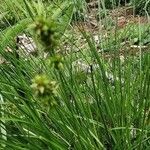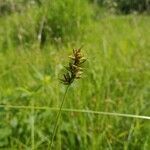Densely cespitose, the stems slender, 2–6(–10) dm, usually conspicuously exceeding the lvs; roots and often the basal sheaths and base of stems purplish-tinged; lvs thin, 2–3 mm wide, with a lanceolate, acute ligule longer than wide; infl cylindric, 2–3.5 cm; spikes 3–10, androgynous, contiguous, subglobose, 5–8 mm; bracts setaceous, to 2 cm, or none; scales triangular-ovate, nearly as long as the perigynia, acute to short-aristate, suffused with orange-brown or purplish-red, the midrib green; perigynia green to stramineous, lance-ovate, planoconvex, corky-thickened at base, 4–5.5 mm, a third to half as wide, finely several-nerved dorsally, nerveless ventrally, gradually narrowed into a rough-margined beak ca half as long as the body; 2n=58, 60. Native of Europe, naturalized from N.S. to Va., w. to O. and Mich. (C. muricata, misapplied)
Stems to 70 cm high, slender. Leaves to 3 mm wide, flat; sheaths often tinged with reddish-purple; ligule ± 4 mm long, much longer than broad. Inflorescence ± 3 cm long, of up to 8 sessile greenish-brown contiguous spikes; bracts, if present, setaceous. Spikes androgynous, male flowers at top. Glumes < utricles, ovate, acute to acuminate, reddish-brown with green midrib. Utricles 4-5 × 2 mm, narrowly ovate, greenish, corky and often furrowed when dry but not nerved at base, gradually tapered to a beak ± 1.5 mm long with finely scabrid margins. Stigmas 2. Nut broad-oblong.












